AUCTORES
Globalize your Research
Research Article | DOI: https://doi.org/10.31579/2692-9759/099
The Maharaja Sayajirao University of Baroda, Vadodara, Gujarat, India.
*Corresponding Author: Prakash Samnani, The Maharaja Sayajirao University of Baroda, Vadodara, Gujarat, India.
Citation: Prakash Samnani, Himakshi Parmar., (2023), Towards Sustainable Development – Increasing Public Participation by Simplifying Water Quality Data Presentation in The Form of Eco-Heart Index, Cardiology Research and Reports. 5(4); DOI:10.31579/2692-9759/099
Copyright: © 2023, Prakash Samnani. This is an open-access article distributed under the terms of the Creative Commons Attribution License, which permits unrestricted use, distribution, and reproduction in any medium, provided the original author and source are credited.
Received: 24 August 2023 | Accepted: 08 September 2023 | Published: 18 September 2023
Keywords: water quality; water quality index; eco-heart index; surface water body; environment monitoring; sustainability
This study applies the new user-friendly and sustainable community-based water quality index known as Eco-Heart Index for monitoring and assessing water quality. Eco-Heart considers six parameters, resulting in a pictorial output in the shape of a heart. A full heart indicates excellent water quality, whereas a broken heart indicates poor water quality. This investigation used six parameters namely, pH, dissolved oxygen, phosphate, nitrate, turbidity, and faecal coliform, for determining the status of a water body. Four water bodies in the city of Vadodara were analyzed using the index to see where they fell on a scale of pollution severity. Based on the Eco-Heart dataset of 3 years, it was found that the lakes in which broken hearts occurred ranged from a shrinking heart to a deformed heart. The obtained results were compared with the widely used National Sanitation Foundation water quality index to validate the data, which showed a moderately positive correlation. Survey documentation for the applicability of the Index on ground level was also carried out using Cronbach Alpha showing a positive response of people for use of Eco- Heart Index indicating that Eco-Heart Index can be used as an alternative, easy, and sustainable tool for assessing water bodies.
Water is the most important natural resource for the existence of life on earth. Owing to industrialization and urbanization, the quality of surface and groundwater has been degrading at a very high rate (Ramprasad, et al., 2020; Uddin, et al., 2021). Considering surface water; rivers, lakes, ponds, and canals play a vital role as drinking water resources. An increasing shortage of clean water is an outcome of the rapid deterioration of surface water quality because of numerous factors, including natural processes, anthropogenic activities, and overdevelopment (Carpenter et al., 1998; Chen, et al., 2003; Nielsen et al., 2012; Wu, et al., 2021). Scientists have shown considerable interest in assessing the ecological health of water bodies in recent decades (Kittinger et al., 2013; Wang, et al., 2018; Yotova, et al., 2021). There are now more intricate approaches that allow the understanding of the vitality of water bodies and their biological response to anthropogenic impact (Bilgin, 2018; Varbanov & Gartsiyanova, 2017; Yotova et al., 2021). To safeguard and control water quality, it is vital to collect important information regarding water quality conditions and its spatiotemporal variation (Romero et al., 2016; Wu, et al., 2021; Zhang, et al., 2019).
To assess the quality of air and water, individual air and water quality indices have been developed. Out of these, the air quality index (AQI) is widely used everywhere on regular basis. The source and information platforms for AQI are relatively well defined and communicated to common people. However, when it comes to the water quality index people are not much aware of it. Some reasons for such non-involvement may be many indices are developed worldwide but no specific universal index is derived; the complexity of mathematical equations used in WQI calculation, which makes it difficult for common people to understand the index at once. To overcome such gaps between science and public participation, a sustainable way of representing information to the public is developed in form of Eco- Heart Index (EHI).
Government policies are aimed at establishing the water quality criteria keeping in mind the health of living organisms of primary importance. USEPA classifies the water quality criteria under three heading namely Aquatic life criteria, Human health criteria, and Organoleptic effects criteria (United States Environment Protection Agency, 2021) In deciding the water quality criteria, EPA takes public opinion along with scientific data. In India, the Government has established channels to bring in various stakeholders in the process of monitoring water quality and improving the quality criteria (Ministry of Jal shakti, Department of water resources, 2022). To increase participation, the water quality monitoring data is shared with the public and opinions are sought about further improvement in the criteria. Going through such a mammoth amount of data is a difficult task for common people and hence there is a need to communicate water quality more simply or realistically.
Though the legal framework in India seeks public participation in getting major projects environmental clearance, the maintenance of ponds in cities and towns is still considered the responsibility of government bodies. There is a dire need to make people in the surrounding areas aware of the factors affecting the quality of water and simpler ways of expressing the water quality.
Several systems have been developed to express water quality using measured quality parameters, such as a statistical approach, model-based approach, or water quality index. In the midst of these methods used for water resource management, WQI plays a crucial role in assessing surface water quality (Mohebbi et al., 2013; Nong et al., 2020; Sutadian et al., 2015; Wu et al., 2021). In WQI, the state of a water body can be determined using mathematical formulas and models (Dash & Kalamdhad, 2021; Stoner, 1978). The most commonly used WQIs in India are the National Sanitation Foundation Water Quality Index (NSFWQI) modified by the Central Pollution Control Board (CPCB), the Canadian Council of Ministers of the Environment Water Quality Index (CCME WQI), Weighted Arithmetic Water Quality Index (WAWQI), Overall Water Quality Index (OWQI), Overall Pollution Index (OIP) (Birawat et al., 2021; Matta et al., 2020; Sargaonkar & Deshpande, 2003; Singh, 2015; Sutadian et al., 2016). Among these, NSWQWI by CPCB, which considers four parameters, namely, dissolved oxygen (DO), pH, faecal coliform, and biological oxygen demand (BOD), is widely used for assessing the quality of a water body. The index value ranges from 0 to 100 depicting polluted and nonpolluted water bodies (Alexakis et al., 2016; Bala et al., 2017; Bora & Goswami, 2017; Gradilla-Hernández et al., 2020). WQI has become an essential component of interpreting the variation or state of the environment for a water body (Dosskey & Qiu, 2011; Sutadian et al., 2016; Terrado et al., 2010) for the following reasons: (a) Provides a general state of water quality for water authorities and the community as a whole (Chang et al., 2001; Ocampo-Duque et al., 2006). (b) Studies the environmental quality implications of regulatory policies and programs (Swamee & Tyagi, 2007). (c) Compares water quality from various sources and sites, without conducting a highly technical evaluation of water quality data (Sarkar & Abbasi, 2006). (d) Assists policymakers and the public in avoiding subjective evaluations and resulting biased views (Ocampo-Duque et al., 2006; Rehana & Mujumdar, 2009).
The main purpose of WQI is to disseminate information about the health of a water body; however, the goal is not fully served, as the local communities get confused with the numbers used by indices, as different ranges are set for each distinct set of developed indices (Debels et al., 2005; Jha et al., 2015; Kannel et al., 2007; Sun et al., 2016). The resultant numerical value from the calculated index is derived when compared with standards and sub-index development, making it difficult for common people to relate to it. Signboards of polluted, nonpolluted, and clean water are seen; however, not every individual can interpret the given information. Thus, to help every individual understand the overall status of a water body, a simpler form of the index was developed, known as Eco-Heart Index. This index comprises of six parameters- pH, ammonia nitrogen, transparency, chemical oxygen demand (COD), dissolved oxygen, and heavy metals (Sakai et al., 2018; Sidek, et al., 2016). Eco-Heart Index mainly includes a heart-shaped tool used for assessing the water body. By looking at the heart shape, one can get an idea about the health and quality of the water body. Theoretical and empirical work on the “Heartware” approach to integrated watershed management (IWM) in Malaysia led to the concept of employing the heart shape. A broken heart represents polluted or dirty water, while a full heart represents clean water (Bakar et al., 2013; Ramprasad et al., 2020; Sakai et al., 2018). Various parameters like pH, turbidity, dissolved oxygen (DO), phosphate, nitrate, and faecal coliforms are determined, and their levels are labelled using a categorization table. Based on the obtained results, all the points are connected through a curved line, and the water quality is evaluated through the heart-shaped figure, where the three basic steps include marking, connecting, and evaluating to form a heart to assess the quality of the water body (Figure 1). If all the parameters are under the class 1 category, then a full heart is obtained indicating a clean water body. A broken heart shape appears if the water is polluted and some of the criteria are not categorized as clean (i.e., level II, III, IV, or V).
This work reports an application of the Eco-Heart Index for the four lake bodies and studied its correlation with the NFSWQI to establish the validity of the index. A survey was also carried out to assess the acceptance of the Eco-heart index in common people and the people living around water bodies. Cronbach Alpha was applied to authenticate effectiveness between asked questions.
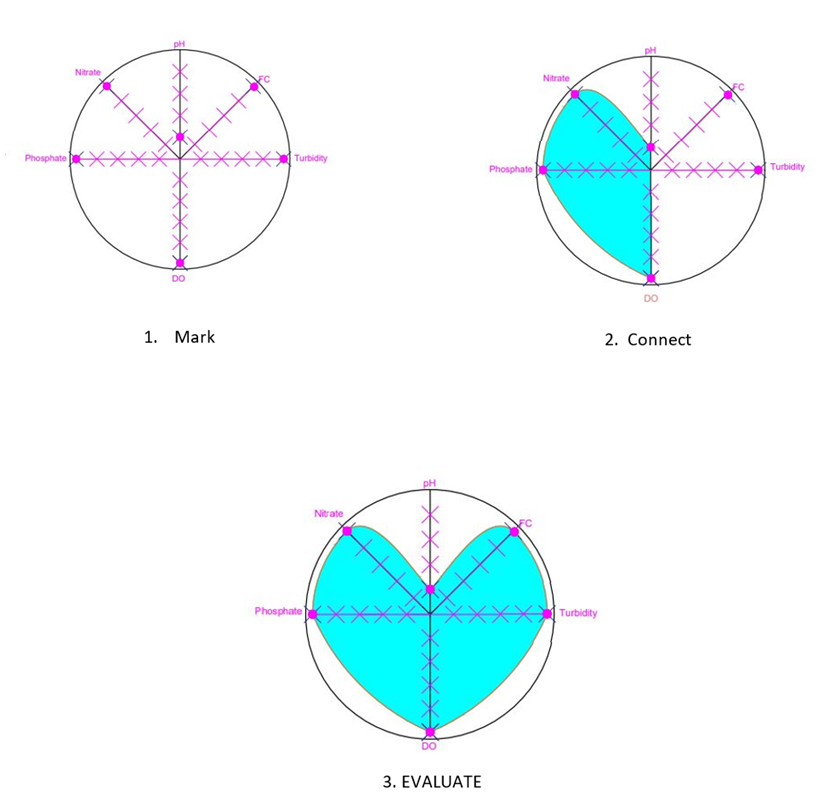
Figure 1: Concept and steps of Eco-heart Index
2.1 Study area
Eco-Heart Index was computed for four urban lake bodies located within the boundaries of the Vadodara municipal corporation (VMC). Vadodara City is a region in central Gujarat, India, located on the banks of the Vishwamitri River at 22°18'52" N latitude and 73°10'53" E longitude having an area of 159.95 sq km (approx.). The city is situated on a fertile plain between the Mahi and Narmada rivers, and the climate is semi-arid due to the region’s high evapotranspiration capacity. The region receives 800 mm of rain per year, although infrequent strong downpour showers create urban flooding. All the lakes chosen for this study are flanked by commercial and residential developments. The water level in all four lakes varies throughout the year. In addition, people living in slums near water bodies use lake water regularly for domestic activities. A detailed map and coordinates of their locations are presented in Figure 2 and Table 1.
| Name of sampling site | Sampling site code | Latitude | Longitude |
|---|---|---|---|
| Harni Lake | S1 | 22°20'17" | 73°13'11" |
| Dhobi Lake | S2 | 22°18'43" | 73°13'10" |
| Gotri Lake | S3 | 22°18'50" | 73°08'03" |
| Sama Lake | S4 | 22°20'34" | 73°12'07" |
Table 1: Geographic coordinates of sample area.
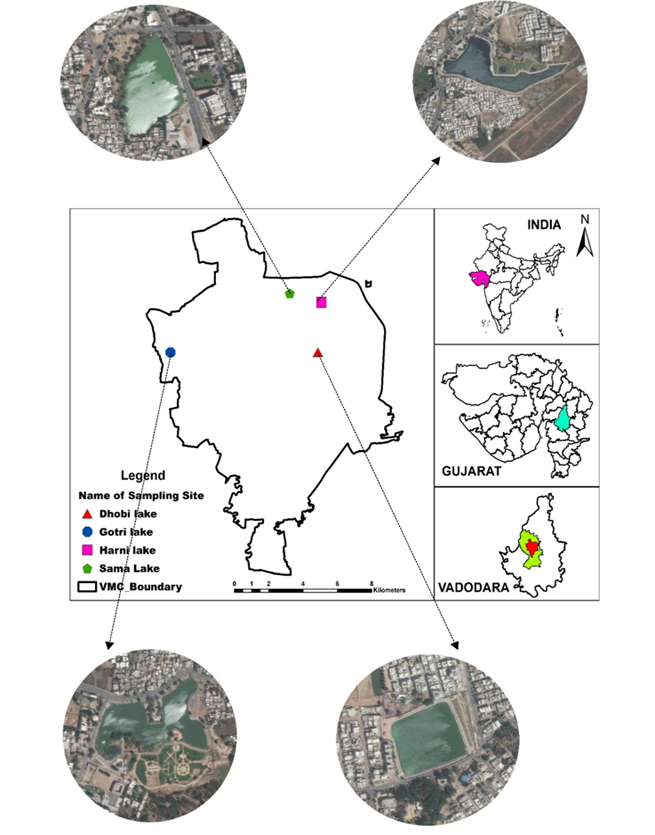
Figure 2: Location Map of the study are
2.2 Sampling and sample analysis
Water samples were collected monthly in the early morning hours between 5 a.m. and 9 a.m. for 3 years, from 2019 to 2021covering all three seasons for water assessment. The sampling stations were selected based on their consistent use, water body-human intervention percentage, and ease of access. Global Positioning System (GPS) recorded the coordinates of the sampling stations. The water samples were collected manually from the subsurface peripheral area of the water body and transferred to an airtight 2-L polyethylene bottle. Before sampling, the bottles were rinsed thrice with distilled water and thrice with sample water. To prevent unexpected changes in physicochemical properties, these samples were transported to the laboratory in an icebox. The samples were analysed within 24 h for pH, turbidity, dissolved oxygen (DO), phosphate, nitrates, and faecal coliforms following the procedures listed in APHA-2017 (APHA-American Public Health Association, American water work Association, 2017; Nathan & Scobell, 2012).
| Parameters | Unit | Analytical methods/Instruments used |
|---|---|---|
| pH | Hanna pH meter | |
| Turbidity | NTU | Nephelometric method |
| Dissolved oxygen | mg/L | Winkler–Azide modification method |
| Phosphate | ppm | Vanadomolybdophosphoric acid colorimetric method |
| Nitrate | ppm | UV/Vis Spectro-photometric method |
| Faecal coliform | MPN | Multiple-tube fermentation technique |
Table 2: Water quality parameters, analytical methods, and instruments used in the study
ix parameters, namely, pH, turbidity, dissolved oxygen (DO), phosphate, nitrate, and faecal coliforms (FC) were determined, and their levels were labelled using a categorization table. Based on the obtained results, all the points were connected through a curved line and water quality was evaluated through the heart-shaped figure thus obtained. If all the six parameters are under the class 1 category, a full heart is obtained indicating a clean water body. A broken heart shape appears if the water is polluted and some of the criteria are not categorized as clean (i.e., level II, III, IV, or V).
The six water performance indicators were chosen to capture both overall water quality and substantial pollution loads, such as eutrophication load by phosphate and nitrate, aesthetic visibility and suspended solids load by turbidity, bacterial contamination by Faecal coliform, and important lake parameters (pH and DO).
| Parameter | I. (Clean) | II. (Moderate) | III. (Slightly polluted) | IV. (Polluted) | V. (Heavily polluted) |
|---|---|---|---|---|---|
| pH | 6.50–7.50 | 6.00–6.49/ 7.51–8.00 | 5.50–5.99/ 8.01–8.50 | 5.0–5.49/ 8.51–9.00 | < 5.00 > 9.00 |
| Dissolved oxygen | 5.50–6.50 | 4.50–5.50 | 3.50–4.50 | 2.00–3.50 | < 2 |
| Faecal coliform | 0–10 | 10–102 | 102–103 | 103–105 | > 105 |
| Phosphate | 0–0.002 | 0.16–0.02 | 0.40–0.16 | 0.40–1.00 | > 1 |
| Nitrate | 0–10 | 10–20 | 20–50 | 50–100 | > 100 |
| Turbidity | 0–5 | 5–15 | 15–50 | 50–100 | > 100 |
Table 3: Classification range for water quality assessment for Eco-Heart Index
Parameters used for the assessment of water quality were classified into five levels, from clean class (I) to heavily polluted (V), as shown in Table 3. The classification for all six parameters was determined using standard values given by CPCB, BIS, and different ranges decided to calculate WQI by NEERI, NIH, and WHO (Sargaonkar & Deshpande, 2003; Singh, 2015).
2.3 Correlation between Eco-Heart Index and NSFWQI
The relationship between Eco-Heart Index and the broadly used NSF index was established with the same data used here to elucidate how the Eco-Heart index is associated with the WQI’s concept. WQIs were calculated using the National Sanitation Foundation Water Quality Index (NSFWQI) (Uddin et al., 2021), where selecting parameters, developing a common scale, and assigning weights was the model on which mathematical equation was developed (Matta et al., 2020). In this method, nine parameters, namely, temperature, pH, turbidity, faecal coliform, dissolved oxygen, biochemical oxygen demand, total phosphates, nitrates, and total solids, are used for index calculation. The water quality data are recorded and transferred to a weighting curve chart, where a numerical value of Qi is obtained (Kumar & Alappat, 2009). The mathematical expression for NSFWQI is given by

where qi represents the assigned curve-based sub-index value (Brown, R.M.; McClelland, N.I.; Deininger, R.A.; Tozer, 1970; Kumar & Alappat, 2009) for the ith variable, which is ranged from 0 to 100, wi represents the weighting coefficient for ith parameter with a range of 0–1. The summation of wi is equal to one. n is the number of total variables considered. The NSFWQI rating scale thus divides water quality into five classes, namely, very bad (0–25), bad (25–50), medium (50–75), good (70–90), or excellent (90–100).
Eco-Heart Index value calculation was done by the summation of all the obtained parameters and values and dividing it by the total number of parameters used in the index calculation. The formula for the same is:

Many WQIs have been developed worldwide using mathematical formulae, artificial intelligence concepts, and software; however, conveying the results of water quality to common people is difficult. Therefore, this work applies the concept of the Eco-Heart Index and assesses its acceptability among people. Further, the validity of the Eco-heart concept was compared with the mathematically developed and widely used NSFWQI using the correlation coefficient function to study the water quality of the lake bodies of Vadodara. The following parameters were determined for 3 years: pH, turbidity, faecal coliform, phosphate, nitrate and dissolved oxygen, and their resultant values are shown in the radar graph below in Figures (3) to (6).
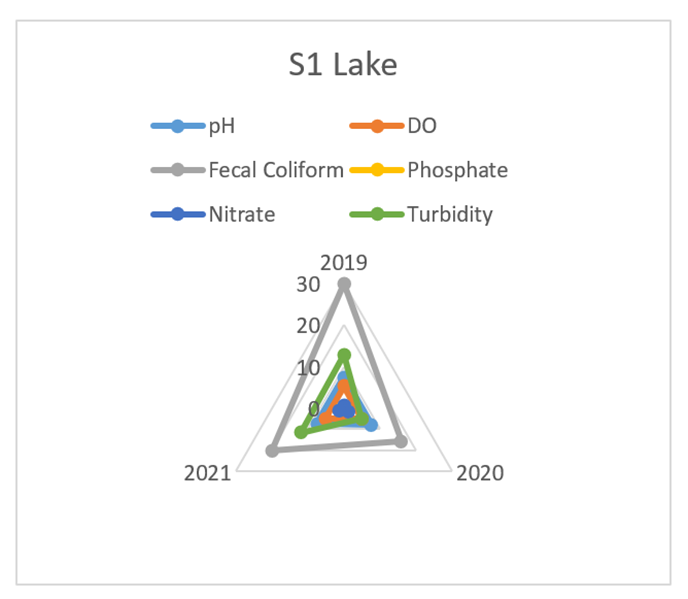
Figure 3: 3 years graph of S1 Lake for six parameters
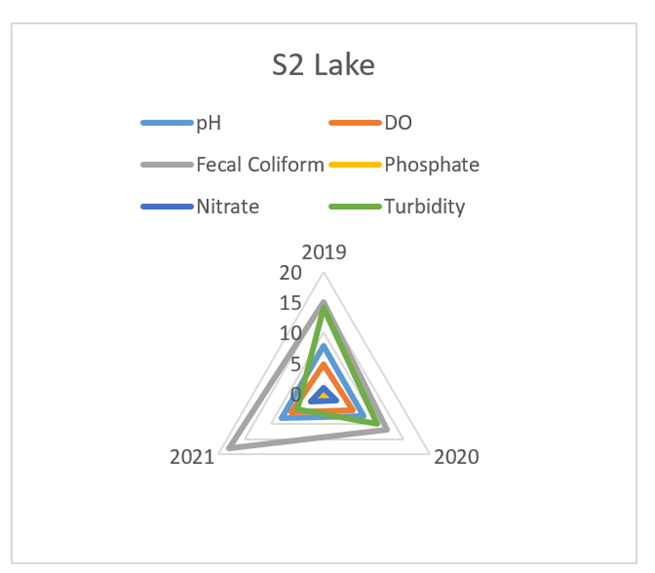
Figure 4: 3 years graph of S2 Lake for six parameters

Figure 5: 3 years graph of S3 Lake for six parameters
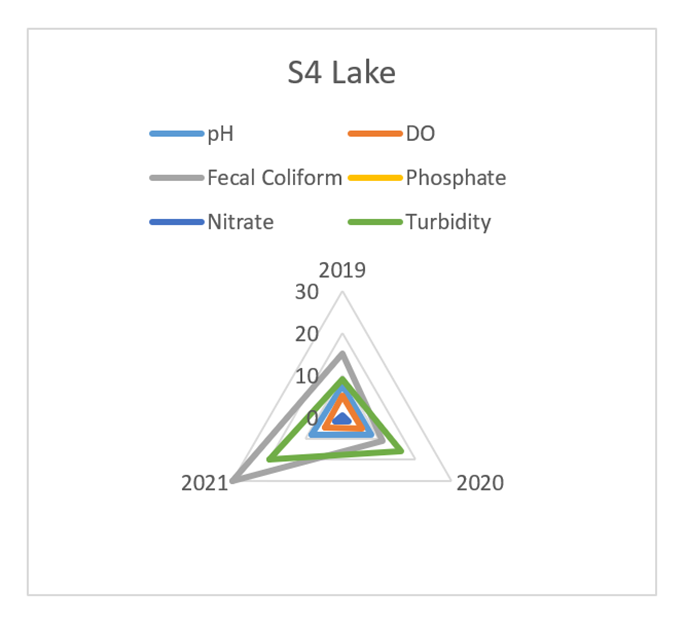
Figure 6: 3 years graph of S4 Lake for six parameters
The minimum and maximum values for all parameters range from 7.5 (S1 lake) to 8.3 (S4 lake) for pH, 4.5 (S3 lake) to 6.6 (S3 lake) for DO, 11 (S4) to 30 (S4, S1 lake) for faecal coliform, 0.13 (S1 lake) to 1.7 (S3 lake) for phosphate, 0.51 (S4 lake) to 2.48 (S2 lake) for nitrate, and 5 (S1 lake) to 20 (S4, S3 lake) for turbidity. These graphs clearly show the parameters dominating in a particular year and the same can be compared with the Eco-Heart given in Figures (7) to (10), which will directly shape the diagram of the heart. For S2 Lake, all parameters (except turbidity) were on an increasing level compared to the parameters of 2019–2020. A sudden increase or decrease in parameters was observed for all the consecutive years for the other three lakes i.e., S3, S4, and S1 Lakes.
For S1 Lake, in 2019, a small heart figure was formed with some parameter edges, namely, faecal coliform, dissolved oxygen, pH, turbidity, and phosphate, bending under the class 2 range. The figure demonstrates water as having good quality. In 2020, a deshaped heart was formed due to a single parameter value fluctuation, i.e., phosphate, while all the other parameters were in the same range as found in 2019 However, the turbidity value decreased compared to that of 2019. From a deshaped heart in 2020 to a full-fledged heart puff edges for four parameters were formed. Compared to 2020, phosphate and pH value came under class 3 from class 4 and class 1 to class 2 for pH. Nitrate, faecal coliform, and dissolved oxygen values remained the same throughout, while turbidity values increased compared to that of 2020. For three consecutive years, a nearly full heart to deshaped heart was observed, indicating the water quality to be under clean to moderate class as shown in Figure 7. The phosphate and turbidity values happened to be the limiting parameters here, which changed the dynamics of water quality.
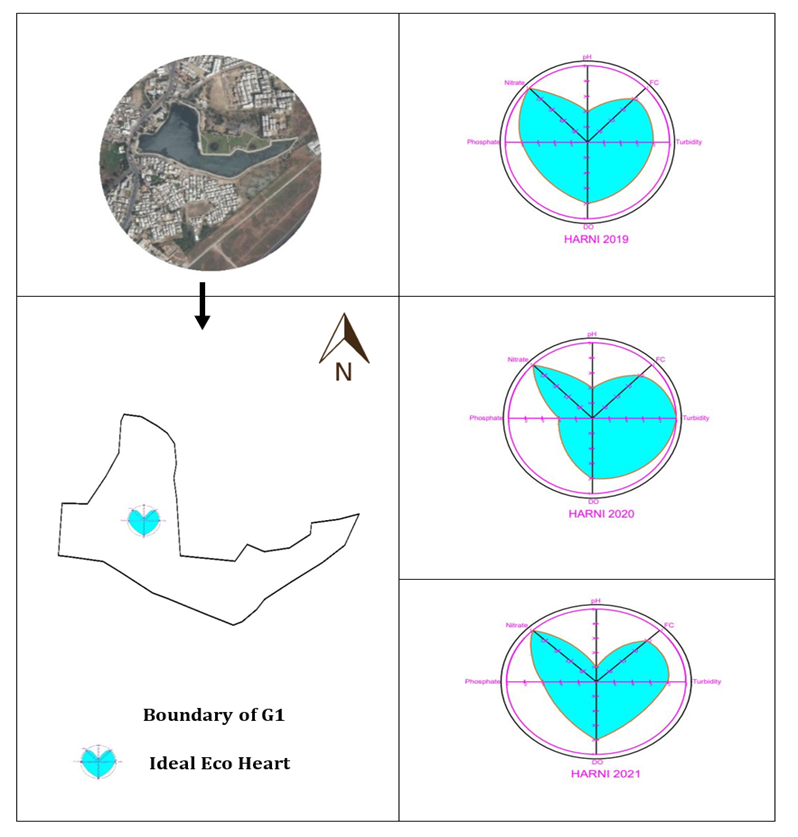
Figure 7: Eco-Heart Index of S1 Lake for 3 years 2019-2020-2021
For S2 Lake, in 2019, the half-formed heart was obtained, shrunk only from one side due to a variation in the pH value. All other parameters were found to be in the desirable range. In 2020, a shrunken heart was formed due to the high value of phosphate. Other parameters, such as DO, faecal coliform, and turbidity, were in an acceptable range. The pH value was found to be in the acceptable range when compared to the 2019 value. In 2021, again one-sided shrunken heart was formed due to a high level of phosphate. All other parameters, such as nitrate, turbidity, and DO, were in the desirable range; however, the pH value slipped down to class 3 when compared to the 2020 value. Faecal coliform remained constant, and the turbidity value decreased compared to that in 2020. For 3 years, different shapes of the heart were seen from a half-formed heart to shrunk heart due to the high level of phosphate and pH fluctuations, indicating that the water quality varied from clean to moderate to slightly polluted class as shown in Figure 8.
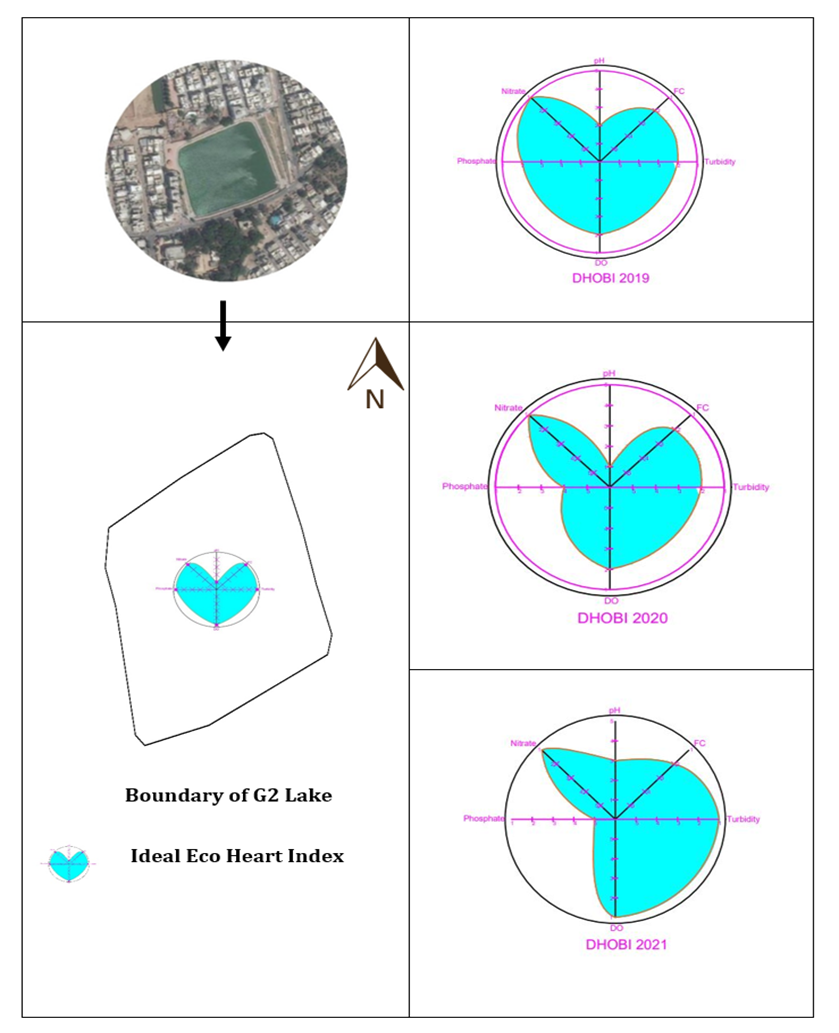
Figure 8: Eco-Heart Index of S2 Lake for 3 years 2019-2020-2021
For S3 Lake, in 2019, a broken heart is formed because of a high level of phosphate, due to which the value falls under the V range, making it heavily polluted under eutrophication pressure and some high values of pH, turbidity, and faecal coliform. In 2020 the same broken heart was formed; however, more pointed curves were present than in 2019, indicating it was a polluted water body due to the high values of pH and phosphate and small changes in resultant values of Faecal coliform and turbidity. By 2021, water quality considerably deteriorated, and a shrunk broken heart was formed due to an increase in turbidity value over the year. The values of phosphate, pH and faecal coliform remained in the same class as in 2020. For all the 3 years, a broken heart was formed mainly due to high values of phosphate and turbidity, making the water body fall under the polluted class as shown in Figure 9.

Figure 9: Eco-Heart Index of S3 Lake for 3 years 2019-2020-2021
For S4 Lake, in 2019, the heart was formed with a pointed curve for 5 out of 6 parameters, making it halfway to produce a full heart. All the other parameters fell under the acceptable range, other than phosphate, which fell under class 3, changing the entire shape of the heart. For 2020 and 2021, a deshaped heart was formed, where all the parameters were in the same class range, except phosphate, which fell under class 4. Water quality deteriorated in 2020–2021, compared to that of 2019, making it moderately to slightly polluted water as shown in below Figure 10.
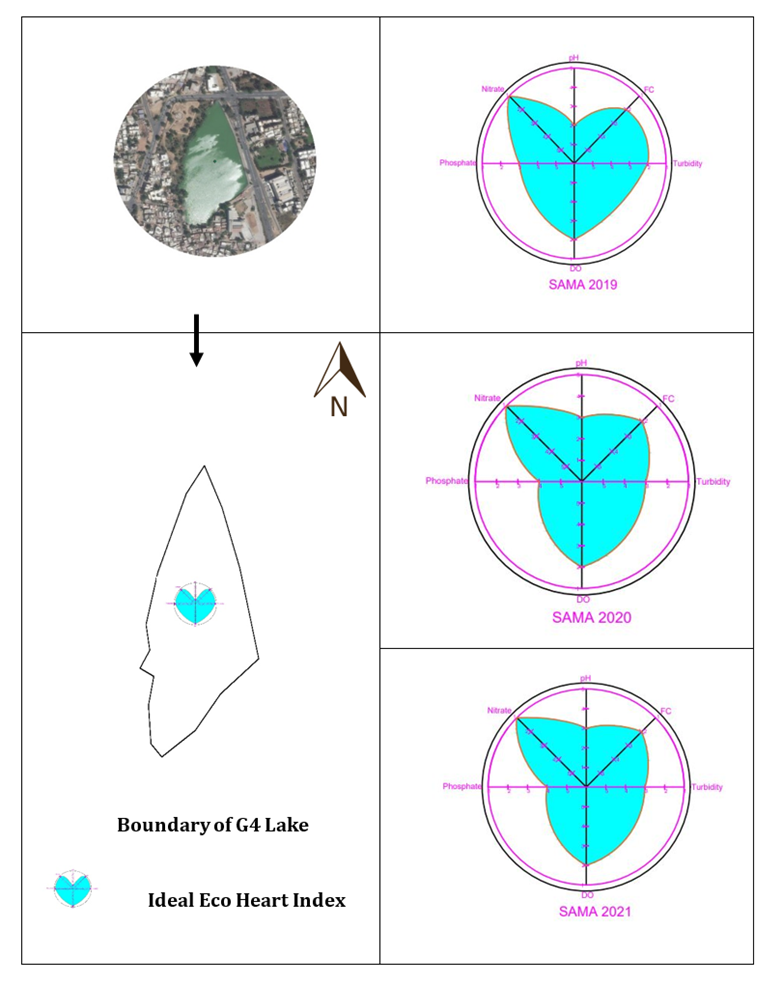
Figure 10: Eco-Heart Index of S4 Lake for 3 years 2019-2020-2021
To understand the fate of the Eco-Heart index in sustainably evaluating the status of the water body, its correlation has been established with the NSFWQI. Both indices showed a moderate positive correlation of 0.4951. A moderate relationship was observed due to the parameter selection, as both were compared using six parameters. However, in NSFWQI, nine parameters are generally considered, the parameter weightage system, which is not seen in EHI, the range classification concept used in EHI, and the weightage graph, which has been used in NSFWQI and not in EHI as it is independently derived to gain basic quality knowledge of water bodies. Despite all these variations, a positive correlation indicated that EHI could be used in assessing the status of water bodies to give the common people a basic idea about water quality. Subsequently, the scientifically developed index can also be interlinked for better and more detailed assessment.
From the results, it was observed that for 2019, all the water bodies could be classified under the clean to moderate class but for 2020 and 2021, the water quality deteriorated for all four ponds. The main parameters, which influence this, were phosphate, turbidity, and pH. A high level of phosphate was mainly due to the sewage discharge and solid waste disposal into the lake bodies, which increased the eutrophication level and lead to the contaminant layer formation by increasing the turbidity level. Thus, the turbidity level increased due to pollutant dispersion from the surrounding areas and improper disposal of solid wastes, such as paper, plastics, and flowers, as all the water, bodies were located near commercial and residential areas. pH fluctuations were observed due to varying anthropogenic activities observed at the water body (Parmar & Samnani, 2022).
All water bodies studied exhibited a deshaped heart and a full heart was not seen for a single water body, indicating that none of the water bodies fell under pristine quality. Since the contributing parameters were only one or two, the water can probably be used for better purposes using simple treatment methods.
To know the effectiveness of the Eco-Heart Index at ground level, a survey was carried out. A google form and personal interaction with people living near water bodies were used in the survey. The total sample size for the study area was 385, out of which 300 data were recorded with all responses making it 78% responses in total. 10 questions were asked with a pictorial representation of the Eco-Heart Index for people to understand the concept and how such a tool can be used for future sustainable practices. The effectiveness and connectivity of the questions asked were assessed using the Cronbach Alpha method. The Cronbach Alpha test evaluates the reliability of the questions in the questionnaire, and the results showed that they had a reliability rating of 0.97 indicating excellent reliability.
Results from the survey are presented below in Figure (11–13). 67% of the people were able to understand the idea of the Eco-Heart Index with 60% in favour of the Eco-Heart Index being the next sustainable tool. However, from the management point of view, mixed responses were gathered, some people opted for using both indices (Numerical and Pictorial) for representation, but some showed disagreement over the new index helping in the conservation of water bodies just by the use of a picture. People living around the periphery of water bodies showed a 50–50 response in use of the Eco-Heart index as many use that water on a day-to-day purpose, so according to them such activity would affect their daily chores while some opted for placing such an image on the periphery so that nearby people would stop polluting the water by throwing garbage to the water body. Such practices would prevent water from being contaminated.
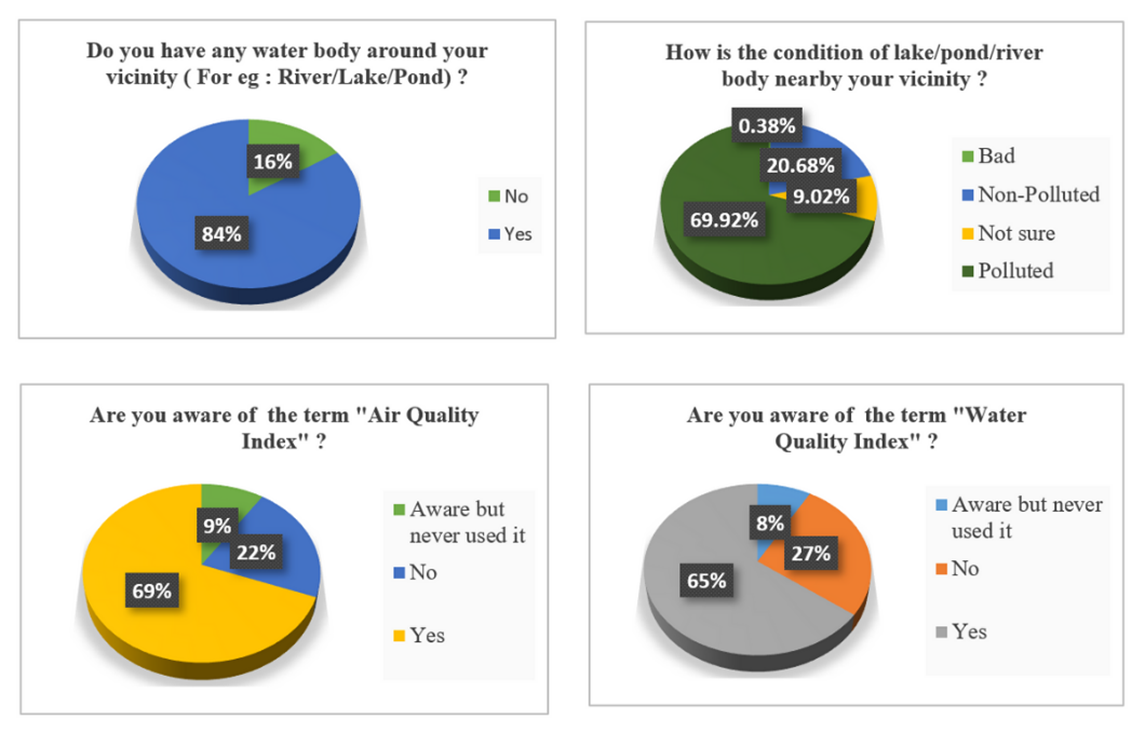
Figure 11: Survey results

Figure 12: Survey results
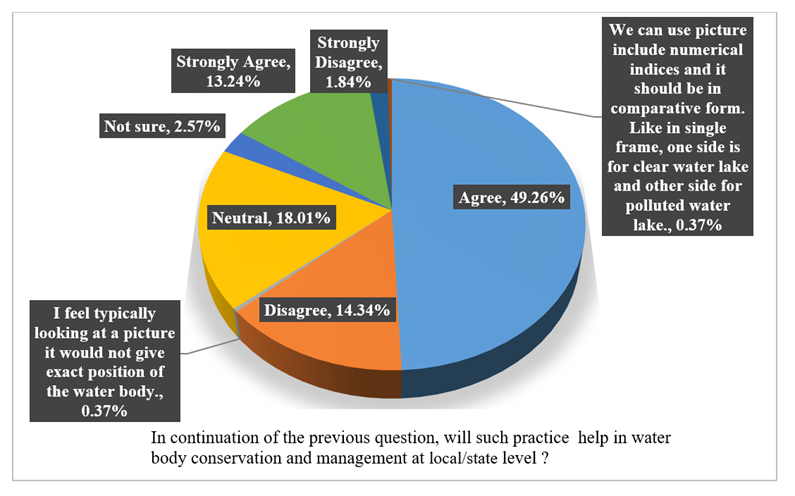
Figure 13: Survey results
Interpreting WQI has been one of the crucial issues for water quality assessment, and the concept of EHI helps to efficiently evaluate the status of the water body, as it is considered a community-based model for a sustainable approach, developed for the common people. Interpretation in the form of a heart shape, which symbolizes love and peace would be more attractive and would involve people’s interest in understanding and accepting it and spreading awareness about the urgent need to save the water bodies by just a small figure. The current scarcity of freshwater tends to indicate the use of lake water for domestic or industrial applications, and hence, its assessment should be based on this understanding and requires modifications in the computation of WQIs. EHI is a simple tool that can be used by common people by assessing it with parameter handy tools. The involvement of six parameters gives a quick informative interpretation of the quality of water bodies, which can be modified as per the requirement of the water body. A positive correlation is formed with NSFWQI; thus, it can be used as an alternative tool for water quality evaluation. Re-categorization of the defined ranges can also be independently conducted according to the pollution load received by the water body and seasonal variation. The questionnaire survey also showed a positive response from people for the implementation of the Eco-Heart index as the new sustainable index. Thus, EHI can be considered a community-based water quality indicator with multiple functions.
The authors declare that they have no known competing financial interests or personal relationships that could have appeared to influence the work reported in this paper.
HP acknowledges the financial support by the SHODH–Scheme of developing high-quality research under the Education Department of Gujarat state (CM Fellowship Program) and Foram Jadeja- a research scholar for her constant support for ARC GIS maps.
The data that support the findings of this study are available from the corresponding author upon reasonable request.
Clearly Auctoresonline and particularly Psychology and Mental Health Care Journal is dedicated to improving health care services for individuals and populations. The editorial boards' ability to efficiently recognize and share the global importance of health literacy with a variety of stakeholders. Auctoresonline publishing platform can be used to facilitate of optimal client-based services and should be added to health care professionals' repertoire of evidence-based health care resources.

Journal of Clinical Cardiology and Cardiovascular Intervention The submission and review process was adequate. However I think that the publication total value should have been enlightened in early fases. Thank you for all.

Journal of Women Health Care and Issues By the present mail, I want to say thank to you and tour colleagues for facilitating my published article. Specially thank you for the peer review process, support from the editorial office. I appreciate positively the quality of your journal.
Journal of Clinical Research and Reports I would be very delighted to submit my testimonial regarding the reviewer board and the editorial office. The reviewer board were accurate and helpful regarding any modifications for my manuscript. And the editorial office were very helpful and supportive in contacting and monitoring with any update and offering help. It was my pleasure to contribute with your promising Journal and I am looking forward for more collaboration.

We would like to thank the Journal of Thoracic Disease and Cardiothoracic Surgery because of the services they provided us for our articles. The peer-review process was done in a very excellent time manner, and the opinions of the reviewers helped us to improve our manuscript further. The editorial office had an outstanding correspondence with us and guided us in many ways. During a hard time of the pandemic that is affecting every one of us tremendously, the editorial office helped us make everything easier for publishing scientific work. Hope for a more scientific relationship with your Journal.

The peer-review process which consisted high quality queries on the paper. I did answer six reviewers’ questions and comments before the paper was accepted. The support from the editorial office is excellent.

Journal of Neuroscience and Neurological Surgery. I had the experience of publishing a research article recently. The whole process was simple from submission to publication. The reviewers made specific and valuable recommendations and corrections that improved the quality of my publication. I strongly recommend this Journal.

Dr. Katarzyna Byczkowska My testimonial covering: "The peer review process is quick and effective. The support from the editorial office is very professional and friendly. Quality of the Clinical Cardiology and Cardiovascular Interventions is scientific and publishes ground-breaking research on cardiology that is useful for other professionals in the field.

Thank you most sincerely, with regard to the support you have given in relation to the reviewing process and the processing of my article entitled "Large Cell Neuroendocrine Carcinoma of The Prostate Gland: A Review and Update" for publication in your esteemed Journal, Journal of Cancer Research and Cellular Therapeutics". The editorial team has been very supportive.

Testimony of Journal of Clinical Otorhinolaryngology: work with your Reviews has been a educational and constructive experience. The editorial office were very helpful and supportive. It was a pleasure to contribute to your Journal.

Dr. Bernard Terkimbi Utoo, I am happy to publish my scientific work in Journal of Women Health Care and Issues (JWHCI). The manuscript submission was seamless and peer review process was top notch. I was amazed that 4 reviewers worked on the manuscript which made it a highly technical, standard and excellent quality paper. I appreciate the format and consideration for the APC as well as the speed of publication. It is my pleasure to continue with this scientific relationship with the esteem JWHCI.

This is an acknowledgment for peer reviewers, editorial board of Journal of Clinical Research and Reports. They show a lot of consideration for us as publishers for our research article “Evaluation of the different factors associated with side effects of COVID-19 vaccination on medical students, Mutah university, Al-Karak, Jordan”, in a very professional and easy way. This journal is one of outstanding medical journal.
Dear Hao Jiang, to Journal of Nutrition and Food Processing We greatly appreciate the efficient, professional and rapid processing of our paper by your team. If there is anything else we should do, please do not hesitate to let us know. On behalf of my co-authors, we would like to express our great appreciation to editor and reviewers.

As an author who has recently published in the journal "Brain and Neurological Disorders". I am delighted to provide a testimonial on the peer review process, editorial office support, and the overall quality of the journal. The peer review process at Brain and Neurological Disorders is rigorous and meticulous, ensuring that only high-quality, evidence-based research is published. The reviewers are experts in their fields, and their comments and suggestions were constructive and helped improve the quality of my manuscript. The review process was timely and efficient, with clear communication from the editorial office at each stage. The support from the editorial office was exceptional throughout the entire process. The editorial staff was responsive, professional, and always willing to help. They provided valuable guidance on formatting, structure, and ethical considerations, making the submission process seamless. Moreover, they kept me informed about the status of my manuscript and provided timely updates, which made the process less stressful. The journal Brain and Neurological Disorders is of the highest quality, with a strong focus on publishing cutting-edge research in the field of neurology. The articles published in this journal are well-researched, rigorously peer-reviewed, and written by experts in the field. The journal maintains high standards, ensuring that readers are provided with the most up-to-date and reliable information on brain and neurological disorders. In conclusion, I had a wonderful experience publishing in Brain and Neurological Disorders. The peer review process was thorough, the editorial office provided exceptional support, and the journal's quality is second to none. I would highly recommend this journal to any researcher working in the field of neurology and brain disorders.

Dear Agrippa Hilda, Journal of Neuroscience and Neurological Surgery, Editorial Coordinator, I trust this message finds you well. I want to extend my appreciation for considering my article for publication in your esteemed journal. I am pleased to provide a testimonial regarding the peer review process and the support received from your editorial office. The peer review process for my paper was carried out in a highly professional and thorough manner. The feedback and comments provided by the authors were constructive and very useful in improving the quality of the manuscript. This rigorous assessment process undoubtedly contributes to the high standards maintained by your journal.

International Journal of Clinical Case Reports and Reviews. I strongly recommend to consider submitting your work to this high-quality journal. The support and availability of the Editorial staff is outstanding and the review process was both efficient and rigorous.

Thank you very much for publishing my Research Article titled “Comparing Treatment Outcome Of Allergic Rhinitis Patients After Using Fluticasone Nasal Spray And Nasal Douching" in the Journal of Clinical Otorhinolaryngology. As Medical Professionals we are immensely benefited from study of various informative Articles and Papers published in this high quality Journal. I look forward to enriching my knowledge by regular study of the Journal and contribute my future work in the field of ENT through the Journal for use by the medical fraternity. The support from the Editorial office was excellent and very prompt. I also welcome the comments received from the readers of my Research Article.

Dear Erica Kelsey, Editorial Coordinator of Cancer Research and Cellular Therapeutics Our team is very satisfied with the processing of our paper by your journal. That was fast, efficient, rigorous, but without unnecessary complications. We appreciated the very short time between the submission of the paper and its publication on line on your site.

I am very glad to say that the peer review process is very successful and fast and support from the Editorial Office. Therefore, I would like to continue our scientific relationship for a long time. And I especially thank you for your kindly attention towards my article. Have a good day!

"We recently published an article entitled “Influence of beta-Cyclodextrins upon the Degradation of Carbofuran Derivatives under Alkaline Conditions" in the Journal of “Pesticides and Biofertilizers” to show that the cyclodextrins protect the carbamates increasing their half-life time in the presence of basic conditions This will be very helpful to understand carbofuran behaviour in the analytical, agro-environmental and food areas. We greatly appreciated the interaction with the editor and the editorial team; we were particularly well accompanied during the course of the revision process, since all various steps towards publication were short and without delay".

I would like to express my gratitude towards you process of article review and submission. I found this to be very fair and expedient. Your follow up has been excellent. I have many publications in national and international journal and your process has been one of the best so far. Keep up the great work.

We are grateful for this opportunity to provide a glowing recommendation to the Journal of Psychiatry and Psychotherapy. We found that the editorial team were very supportive, helpful, kept us abreast of timelines and over all very professional in nature. The peer review process was rigorous, efficient and constructive that really enhanced our article submission. The experience with this journal remains one of our best ever and we look forward to providing future submissions in the near future.

I am very pleased to serve as EBM of the journal, I hope many years of my experience in stem cells can help the journal from one way or another. As we know, stem cells hold great potential for regenerative medicine, which are mostly used to promote the repair response of diseased, dysfunctional or injured tissue using stem cells or their derivatives. I think Stem Cell Research and Therapeutics International is a great platform to publish and share the understanding towards the biology and translational or clinical application of stem cells.

I would like to give my testimony in the support I have got by the peer review process and to support the editorial office where they were of asset to support young author like me to be encouraged to publish their work in your respected journal and globalize and share knowledge across the globe. I really give my great gratitude to your journal and the peer review including the editorial office.

I am delighted to publish our manuscript entitled "A Perspective on Cocaine Induced Stroke - Its Mechanisms and Management" in the Journal of Neuroscience and Neurological Surgery. The peer review process, support from the editorial office, and quality of the journal are excellent. The manuscripts published are of high quality and of excellent scientific value. I recommend this journal very much to colleagues.

Dr.Tania Muñoz, My experience as researcher and author of a review article in The Journal Clinical Cardiology and Interventions has been very enriching and stimulating. The editorial team is excellent, performs its work with absolute responsibility and delivery. They are proactive, dynamic and receptive to all proposals. Supporting at all times the vast universe of authors who choose them as an option for publication. The team of review specialists, members of the editorial board, are brilliant professionals, with remarkable performance in medical research and scientific methodology. Together they form a frontline team that consolidates the JCCI as a magnificent option for the publication and review of high-level medical articles and broad collective interest. I am honored to be able to share my review article and open to receive all your comments.

“The peer review process of JPMHC is quick and effective. Authors are benefited by good and professional reviewers with huge experience in the field of psychology and mental health. The support from the editorial office is very professional. People to contact to are friendly and happy to help and assist any query authors might have. Quality of the Journal is scientific and publishes ground-breaking research on mental health that is useful for other professionals in the field”.

Dear editorial department: On behalf of our team, I hereby certify the reliability and superiority of the International Journal of Clinical Case Reports and Reviews in the peer review process, editorial support, and journal quality. Firstly, the peer review process of the International Journal of Clinical Case Reports and Reviews is rigorous, fair, transparent, fast, and of high quality. The editorial department invites experts from relevant fields as anonymous reviewers to review all submitted manuscripts. These experts have rich academic backgrounds and experience, and can accurately evaluate the academic quality, originality, and suitability of manuscripts. The editorial department is committed to ensuring the rigor of the peer review process, while also making every effort to ensure a fast review cycle to meet the needs of authors and the academic community. Secondly, the editorial team of the International Journal of Clinical Case Reports and Reviews is composed of a group of senior scholars and professionals with rich experience and professional knowledge in related fields. The editorial department is committed to assisting authors in improving their manuscripts, ensuring their academic accuracy, clarity, and completeness. Editors actively collaborate with authors, providing useful suggestions and feedback to promote the improvement and development of the manuscript. We believe that the support of the editorial department is one of the key factors in ensuring the quality of the journal. Finally, the International Journal of Clinical Case Reports and Reviews is renowned for its high- quality articles and strict academic standards. The editorial department is committed to publishing innovative and academically valuable research results to promote the development and progress of related fields. The International Journal of Clinical Case Reports and Reviews is reasonably priced and ensures excellent service and quality ratio, allowing authors to obtain high-level academic publishing opportunities in an affordable manner. I hereby solemnly declare that the International Journal of Clinical Case Reports and Reviews has a high level of credibility and superiority in terms of peer review process, editorial support, reasonable fees, and journal quality. Sincerely, Rui Tao.

Clinical Cardiology and Cardiovascular Interventions I testity the covering of the peer review process, support from the editorial office, and quality of the journal.

Clinical Cardiology and Cardiovascular Interventions, we deeply appreciate the interest shown in our work and its publication. It has been a true pleasure to collaborate with you. The peer review process, as well as the support provided by the editorial office, have been exceptional, and the quality of the journal is very high, which was a determining factor in our decision to publish with you.
The peer reviewers process is quick and effective, the supports from editorial office is excellent, the quality of journal is high. I would like to collabroate with Internatioanl journal of Clinical Case Reports and Reviews journal clinically in the future time.

Clinical Cardiology and Cardiovascular Interventions, I would like to express my sincerest gratitude for the trust placed in our team for the publication in your journal. It has been a true pleasure to collaborate with you on this project. I am pleased to inform you that both the peer review process and the attention from the editorial coordination have been excellent. Your team has worked with dedication and professionalism to ensure that your publication meets the highest standards of quality. We are confident that this collaboration will result in mutual success, and we are eager to see the fruits of this shared effort.

Dear Dr. Jessica Magne, Editorial Coordinator 0f Clinical Cardiology and Cardiovascular Interventions, I hope this message finds you well. I want to express my utmost gratitude for your excellent work and for the dedication and speed in the publication process of my article titled "Navigating Innovation: Qualitative Insights on Using Technology for Health Education in Acute Coronary Syndrome Patients." I am very satisfied with the peer review process, the support from the editorial office, and the quality of the journal. I hope we can maintain our scientific relationship in the long term.
Dear Monica Gissare, - Editorial Coordinator of Nutrition and Food Processing. ¨My testimony with you is truly professional, with a positive response regarding the follow-up of the article and its review, you took into account my qualities and the importance of the topic¨.

Dear Dr. Jessica Magne, Editorial Coordinator 0f Clinical Cardiology and Cardiovascular Interventions, The review process for the article “The Handling of Anti-aggregants and Anticoagulants in the Oncologic Heart Patient Submitted to Surgery” was extremely rigorous and detailed. From the initial submission to the final acceptance, the editorial team at the “Journal of Clinical Cardiology and Cardiovascular Interventions” demonstrated a high level of professionalism and dedication. The reviewers provided constructive and detailed feedback, which was essential for improving the quality of our work. Communication was always clear and efficient, ensuring that all our questions were promptly addressed. The quality of the “Journal of Clinical Cardiology and Cardiovascular Interventions” is undeniable. It is a peer-reviewed, open-access publication dedicated exclusively to disseminating high-quality research in the field of clinical cardiology and cardiovascular interventions. The journal's impact factor is currently under evaluation, and it is indexed in reputable databases, which further reinforces its credibility and relevance in the scientific field. I highly recommend this journal to researchers looking for a reputable platform to publish their studies.

Dear Editorial Coordinator of the Journal of Nutrition and Food Processing! "I would like to thank the Journal of Nutrition and Food Processing for including and publishing my article. The peer review process was very quick, movement and precise. The Editorial Board has done an extremely conscientious job with much help, valuable comments and advices. I find the journal very valuable from a professional point of view, thank you very much for allowing me to be part of it and I would like to participate in the future!”

Dealing with The Journal of Neurology and Neurological Surgery was very smooth and comprehensive. The office staff took time to address my needs and the response from editors and the office was prompt and fair. I certainly hope to publish with this journal again.Their professionalism is apparent and more than satisfactory. Susan Weiner

My Testimonial Covering as fellowing: Lin-Show Chin. The peer reviewers process is quick and effective, the supports from editorial office is excellent, the quality of journal is high. I would like to collabroate with Internatioanl journal of Clinical Case Reports and Reviews.

My experience publishing in Psychology and Mental Health Care was exceptional. The peer review process was rigorous and constructive, with reviewers providing valuable insights that helped enhance the quality of our work. The editorial team was highly supportive and responsive, making the submission process smooth and efficient. The journal's commitment to high standards and academic rigor makes it a respected platform for quality research. I am grateful for the opportunity to publish in such a reputable journal.
My experience publishing in International Journal of Clinical Case Reports and Reviews was exceptional. I Come forth to Provide a Testimonial Covering the Peer Review Process and the editorial office for the Professional and Impartial Evaluation of the Manuscript.

I would like to offer my testimony in the support. I have received through the peer review process and support the editorial office where they are to support young authors like me, encourage them to publish their work in your esteemed journals, and globalize and share knowledge globally. I really appreciate your journal, peer review, and editorial office.
Dear Agrippa Hilda- Editorial Coordinator of Journal of Neuroscience and Neurological Surgery, "The peer review process was very quick and of high quality, which can also be seen in the articles in the journal. The collaboration with the editorial office was very good."

I would like to express my sincere gratitude for the support and efficiency provided by the editorial office throughout the publication process of my article, “Delayed Vulvar Metastases from Rectal Carcinoma: A Case Report.” I greatly appreciate the assistance and guidance I received from your team, which made the entire process smooth and efficient. The peer review process was thorough and constructive, contributing to the overall quality of the final article. I am very grateful for the high level of professionalism and commitment shown by the editorial staff, and I look forward to maintaining a long-term collaboration with the International Journal of Clinical Case Reports and Reviews.
To Dear Erin Aust, I would like to express my heartfelt appreciation for the opportunity to have my work published in this esteemed journal. The entire publication process was smooth and well-organized, and I am extremely satisfied with the final result. The Editorial Team demonstrated the utmost professionalism, providing prompt and insightful feedback throughout the review process. Their clear communication and constructive suggestions were invaluable in enhancing my manuscript, and their meticulous attention to detail and dedication to quality are truly commendable. Additionally, the support from the Editorial Office was exceptional. From the initial submission to the final publication, I was guided through every step of the process with great care and professionalism. The team's responsiveness and assistance made the entire experience both easy and stress-free. I am also deeply impressed by the quality and reputation of the journal. It is an honor to have my research featured in such a respected publication, and I am confident that it will make a meaningful contribution to the field.

"I am grateful for the opportunity of contributing to [International Journal of Clinical Case Reports and Reviews] and for the rigorous review process that enhances the quality of research published in your esteemed journal. I sincerely appreciate the time and effort of your team who have dedicatedly helped me in improvising changes and modifying my manuscript. The insightful comments and constructive feedback provided have been invaluable in refining and strengthening my work".

I thank the ‘Journal of Clinical Research and Reports’ for accepting this article for publication. This is a rigorously peer reviewed journal which is on all major global scientific data bases. I note the review process was prompt, thorough and professionally critical. It gave us an insight into a number of important scientific/statistical issues. The review prompted us to review the relevant literature again and look at the limitations of the study. The peer reviewers were open, clear in the instructions and the editorial team was very prompt in their communication. This journal certainly publishes quality research articles. I would recommend the journal for any future publications.

Dear Jessica Magne, with gratitude for the joint work. Fast process of receiving and processing the submitted scientific materials in “Clinical Cardiology and Cardiovascular Interventions”. High level of competence of the editors with clear and correct recommendations and ideas for enriching the article.

We found the peer review process quick and positive in its input. The support from the editorial officer has been very agile, always with the intention of improving the article and taking into account our subsequent corrections.

My article, titled 'No Way Out of the Smartphone Epidemic Without Considering the Insights of Brain Research,' has been republished in the International Journal of Clinical Case Reports and Reviews. The review process was seamless and professional, with the editors being both friendly and supportive. I am deeply grateful for their efforts.
To Dear Erin Aust – Editorial Coordinator of Journal of General Medicine and Clinical Practice! I declare that I am absolutely satisfied with your work carried out with great competence in following the manuscript during the various stages from its receipt, during the revision process to the final acceptance for publication. Thank Prof. Elvira Farina

Dear Jessica, and the super professional team of the ‘Clinical Cardiology and Cardiovascular Interventions’ I am sincerely grateful to the coordinated work of the journal team for the no problem with the submission of my manuscript: “Cardiometabolic Disorders in A Pregnant Woman with Severe Preeclampsia on the Background of Morbid Obesity (Case Report).” The review process by 5 experts was fast, and the comments were professional, which made it more specific and academic, and the process of publication and presentation of the article was excellent. I recommend that my colleagues publish articles in this journal, and I am interested in further scientific cooperation. Sincerely and best wishes, Dr. Oleg Golyanovskiy.

Dear Ashley Rosa, Editorial Coordinator of the journal - Psychology and Mental Health Care. " The process of obtaining publication of my article in the Psychology and Mental Health Journal was positive in all areas. The peer review process resulted in a number of valuable comments, the editorial process was collaborative and timely, and the quality of this journal has been quickly noticed, resulting in alternative journals contacting me to publish with them." Warm regards, Susan Anne Smith, PhD. Australian Breastfeeding Association.

Dear Jessica Magne, Editorial Coordinator, Clinical Cardiology and Cardiovascular Interventions, Auctores Publishing LLC. I appreciate the journal (JCCI) editorial office support, the entire team leads were always ready to help, not only on technical front but also on thorough process. Also, I should thank dear reviewers’ attention to detail and creative approach to teach me and bring new insights by their comments. Surely, more discussions and introduction of other hemodynamic devices would provide better prevention and management of shock states. Your efforts and dedication in presenting educational materials in this journal are commendable. Best wishes from, Farahnaz Fallahian.
Dear Maria Emerson, Editorial Coordinator, International Journal of Clinical Case Reports and Reviews, Auctores Publishing LLC. I am delighted to have published our manuscript, "Acute Colonic Pseudo-Obstruction (ACPO): A rare but serious complication following caesarean section." I want to thank the editorial team, especially Maria Emerson, for their prompt review of the manuscript, quick responses to queries, and overall support. Yours sincerely Dr. Victor Olagundoye.

Dear Ashley Rosa, Editorial Coordinator, International Journal of Clinical Case Reports and Reviews. Many thanks for publishing this manuscript after I lost confidence the editors were most helpful, more than other journals Best wishes from, Susan Anne Smith, PhD. Australian Breastfeeding Association.

Dear Agrippa Hilda, Editorial Coordinator, Journal of Neuroscience and Neurological Surgery. The entire process including article submission, review, revision, and publication was extremely easy. The journal editor was prompt and helpful, and the reviewers contributed to the quality of the paper. Thank you so much! Eric Nussbaum, MD
Dr Hala Al Shaikh This is to acknowledge that the peer review process for the article ’ A Novel Gnrh1 Gene Mutation in Four Omani Male Siblings, Presentation and Management ’ sent to the International Journal of Clinical Case Reports and Reviews was quick and smooth. The editorial office was prompt with easy communication.

Dear Erin Aust, Editorial Coordinator, Journal of General Medicine and Clinical Practice. We are pleased to share our experience with the “Journal of General Medicine and Clinical Practice”, following the successful publication of our article. The peer review process was thorough and constructive, helping to improve the clarity and quality of the manuscript. We are especially thankful to Ms. Erin Aust, the Editorial Coordinator, for her prompt communication and continuous support throughout the process. Her professionalism ensured a smooth and efficient publication experience. The journal upholds high editorial standards, and we highly recommend it to fellow researchers seeking a credible platform for their work. Best wishes By, Dr. Rakhi Mishra.

Dear Jessica Magne, Editorial Coordinator, Clinical Cardiology and Cardiovascular Interventions, Auctores Publishing LLC. The peer review process of the journal of Clinical Cardiology and Cardiovascular Interventions was excellent and fast, as was the support of the editorial office and the quality of the journal. Kind regards Walter F. Riesen Prof. Dr. Dr. h.c. Walter F. Riesen.

Dear Ashley Rosa, Editorial Coordinator, International Journal of Clinical Case Reports and Reviews, Auctores Publishing LLC. Thank you for publishing our article, Exploring Clozapine's Efficacy in Managing Aggression: A Multiple Single-Case Study in Forensic Psychiatry in the international journal of clinical case reports and reviews. We found the peer review process very professional and efficient. The comments were constructive, and the whole process was efficient. On behalf of the co-authors, I would like to thank you for publishing this article. With regards, Dr. Jelle R. Lettinga.

Dear Clarissa Eric, Editorial Coordinator, Journal of Clinical Case Reports and Studies, I would like to express my deep admiration for the exceptional professionalism demonstrated by your journal. I am thoroughly impressed by the speed of the editorial process, the substantive and insightful reviews, and the meticulous preparation of the manuscript for publication. Additionally, I greatly appreciate the courteous and immediate responses from your editorial office to all my inquiries. Best Regards, Dariusz Ziora

Dear Chrystine Mejia, Editorial Coordinator, Journal of Neurodegeneration and Neurorehabilitation, Auctores Publishing LLC, We would like to thank the editorial team for the smooth and high-quality communication leading up to the publication of our article in the Journal of Neurodegeneration and Neurorehabilitation. The reviewers have extensive knowledge in the field, and their relevant questions helped to add value to our publication. Kind regards, Dr. Ravi Shrivastava.

Dear Clarissa Eric, Editorial Coordinator, Journal of Clinical Case Reports and Studies, Auctores Publishing LLC, USA Office: +1-(302)-520-2644. I would like to express my sincere appreciation for the efficient and professional handling of my case report by the ‘Journal of Clinical Case Reports and Studies’. The peer review process was not only fast but also highly constructive—the reviewers’ comments were clear, relevant, and greatly helped me improve the quality and clarity of my manuscript. I also received excellent support from the editorial office throughout the process. Communication was smooth and timely, and I felt well guided at every stage, from submission to publication. The overall quality and rigor of the journal are truly commendable. I am pleased to have published my work with Journal of Clinical Case Reports and Studies, and I look forward to future opportunities for collaboration. Sincerely, Aline Tollet, UCLouvain.

Dear Ms. Mayra Duenas, Editorial Coordinator, International Journal of Clinical Case Reports and Reviews. “The International Journal of Clinical Case Reports and Reviews represented the “ideal house” to share with the research community a first experience with the use of the Simeox device for speech rehabilitation. High scientific reputation and attractive website communication were first determinants for the selection of this Journal, and the following submission process exceeded expectations: fast but highly professional peer review, great support by the editorial office, elegant graphic layout. Exactly what a dynamic research team - also composed by allied professionals - needs!" From, Chiara Beccaluva, PT - Italy.

Dear Maria Emerson, Editorial Coordinator, we have deeply appreciated the professionalism demonstrated by the International Journal of Clinical Case Reports and Reviews. The reviewers have extensive knowledge of our field and have been very efficient and fast in supporting the process. I am really looking forward to further collaboration. Thanks. Best regards, Dr. Claudio Ligresti